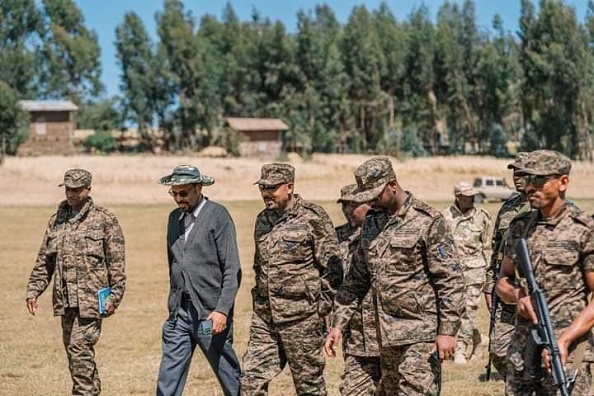Addis Ababa – Ethiopia’s military this week regained control of territory previously claimed by Tigrayan rebels, a potential validation of Prime Minister Abiy Ahmed’s decision to join soldiers to conflict-hit areas.
Yet how the government scored its wins and what they mean for an eventual outcome in the year-old war remain points of fierce debate as fighting enters a new, uncertain phase.
Just a month ago, the Tigray People’s Liberation Front (TPLF) rebel group appeared to be on the offensive, claiming to have captured Dessie and Kombolcha, towns on a key highway headed towards the capital Addis Ababa.
They reportedly reached as far as Shewa Robit, around 220km (135 miles) northeast of Addis Ababa by road.
ALSO READ | Ethiopia govt claims to retake Unesco site Lalibela from rebels
But after Abiy announced last week he would lead operations in the field, the government announced a string of victories and the rebels acknowledged making adjustments to their strategy.
State media has responded with triumphalist wall-to-wall coverage.
“The enemy is destroyed, disintegrated,” the Ethiopian Broadcasting Corporation quoted Abiy as saying Thursday.
There’s little doubt the government can claim to have the “upper hand” in specific areas, said Awet Weldemichael, a Horn of Africa security expert at Queen’s University in Canada.
“Only time will tell if these can be translated into [the] upper hand in the war,” he said.
A surprise shift
The war in northern Ethiopia broke out in November 2020 when Abiy sent troops to topple the TPLF — a move he said came in response to TPLF attacks on federal army camps.
Though Abiy, the 2019 Nobel Peace Prize winner, promised a quick victory, by late June the TPLF had retaken most of Tigray, and it soon launched offensives into neighbouring Afar and Amhara regions.
The rebels’ march towards Addis sparked international panic, with a host of embassies urging their citizens to leave the country as soon as possible.
All the while, though, the exact nature of the TPLF advance was in dispute.
“I don’t know whether we should call it an advance,” one Western security official told AFP in mid-November.
“There’s not a huge column of tanks and armoured vehicles driving down the road towards Addis. It’s more complex than that. There are foot soldiers going into the mountains, they shoot and surround certain areas” but do not seem to fully control cities and towns, the official said.
ALSO READ | Ethiopia govt claims retake of town near capital
The TPLF also never explicitly said it wanted to enter Addis Ababa, instead simply declining to rule out such a move.
The latest battlefield shifts unfolded swiftly.
The government first claimed towns in Afar, near a critical highway bringing goods to Addis Ababa, then on Wednesday it declared victory in Lalibela, a UNESCO World Heritage site that fell to the TPLF in August.
On Friday state media announced that towns on the road heading north towards Dessie and Kombolcha had been “liberated”.
The news could be a sign that government forces, as well as many thousands of new recruits who have enlisted in recent months, have more fight than they’ve gotten credit for.
“I was quite surprised by the latest counteroffensive by the government,” said Mehdi Labzae, a sociologist who studies land issues and mobilisation in Ethiopia.
“I have seen all the people who were mobilised… but the thing is I thought they were not trained and I thought they would just be destroyed.”
The path ahead
The African Union is trying to broker a ceasefire to avert further bloodshed, though there has been little progress so far.
The TPLF insists it will have the advantage in whatever fighting is to come.
“In battle, it’s known there will be adjustments and limited retreat as well as significant moves forward,” TPLF military boss Tadesse Worede said in an interview that aired Friday.
“We decided that to reduce problems and vulnerabilities in some areas we had reached, to leave some of those places voluntarily.”
ALSO READ | Ethiopia PM Abiy Ahmed claims war gains, urges rebels to ‘surrender’
For Labzae, such statements recall the government’s announcement that it was withdrawing from most of Tigray in late June — a claim that elided military setbacks even as TPLF fighters celebrated in the streets of the regional capital Mekele.
“They were so close [to Addis]. Why would they turn back now?” Labzae said of the TPLF.
“It means there was something worrying them or something that did not look good for them.”
One possibility, said Awet of Queen’s University, is that the government’s superior air power has turned the tide — at least for now.
“Drones are claimed to have played a decisive role in active combat, the full extent of which we are yet to find out,” he said.
“But so far, it appears like they have helped halt Tigrayan counterattacks and advances.”
Follow African Insider on Facebook, Twitter and Instagram
Source: AFP
Picture: Getty Images
For more African news, visit Africaninsider.com


